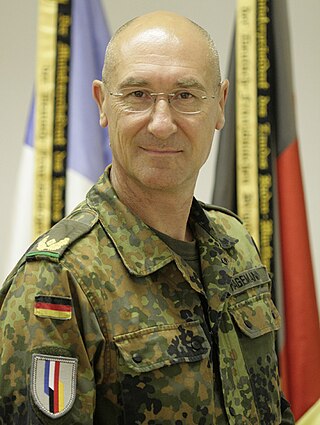Generalfeldmarschall was a rank in the armies of several German states and the Holy Roman Empire (Reichsgeneralfeldmarschall); in the Habsburg monarchy, the Austrian Empire and Austria-Hungary, the rank Feldmarschall was used. The rank was the equivalent to Großadmiral in the Kaiserliche Marine and Kriegsmarine, a five-star rank, comparable to OF-10 in today's NATO naval forces.

The Biographical Dictionary of the Extreme Right Since 1890 is a reference book by Philip Rees, on leading people in the various far right movements since 1890. It contains entries for what the author regards as "the 500 major figures on the radical right, extreme right, and revolutionary right from 1890 to the present" . It was published, as a 418-page hardcover, in New York by Simon & Schuster in 1990 (ISBN 0-13-089301-3).

A Generaloberst was the second-highest general officer rank in the German Reichswehr and Wehrmacht, the Austro-Hungarian Common Army, the East German National People's Army and in their respective police services. The rank was equal to a four-star full general but below a general field marshal. The rank was equivalent to a Generaladmiral in the Kriegsmarine until 1945 or to a Flottenadmiral in the Volksmarine until 1990. It was the highest ordinary military rank and the highest military rank awarded in peacetime; the higher rank of general field marshal was awarded only in wartime by the head of state. In general, a Generaloberst had the same privileges as a general field marshal.

The Hagenbund or Künstlerbund Hagen was a group of Austrian artists that formed in 1899. The group's name derived from the name Herr Hagen, the proprietor of an inn in Vienna which they frequented.

This is a list of members of the 4th Reichstag – the parliament of the Weimar Republic, whose members were elected in the 1928 federal election and served in office from 1928 until its dissolution in 1930.

General der Artillerie may mean:

The Gottbegnadeten-Liste was a 36-page list of artists considered crucial to National Socialist culture. The list was assembled in September 1944 by Joseph Goebbels, the head of the Ministry of Public Enlightenment and Propaganda, and Germany's supreme leader Adolf Hitler.

General of the Infantry is a former rank of the German army. It is currently an appointment or position given to an OF-8 rank officer, who is responsible for particular affairs of training and equipment of the Bundeswehr infantry.

General der Panzertruppe was a General of the branch rank of the German Army, introduced in 1935. A General der Panzertruppe was a lieutenant general, above major general (Generalleutnant), commanding a Panzer corps.

General der Gebirgstruppe was a category of German Army three-star, a new example of the traditional German 'General der rank introduced by the Wehrmacht in 1940, comparable to the NATO grade OF-8.
The Gelöbnis treuester Gefolgschaft was a declaration by 88 German writers and poets of their loyalty to Adolf Hitler. It was printed in the Vossische Zeitung on 26 October 1933 and publicised by the Prussian Academy of Arts in Berlin. It was also published in other newspapers, such as the Frankfurter Zeitung, to widen public awareness of the confidence of the signed poets and writers in Hitler as the Chancellor of Germany.

General of the Cavalry was a General of the branch rank in the Imperial Army, the interwar Reichswehr, and the Wehrmacht. It was the second-highest general officer rank below Generaloberst.

General der Flakartillerie was a General of the branch rank of the Luftwaffe in Nazi Germany. Until the end of World War II in 1945, this particular general officer rank was on three-star level (OF-8), equivalent to a US Lieutenant general.
Members of the Bavarian Maximilian Order for Science and Art, awarded to acknowledge and reward excellent and outstanding achievements in the fields of science and art. It is based in Bavaria, Germany.
The Reich Cultural Senate was a body directly subordinate to the Nazi Reich Chamber of Culture, created by Chamber President and Reich Propaganda Minister Joseph Goebbels on 15 November 1935.
This page is based on this
Wikipedia article Text is available under the
CC BY-SA 4.0 license; additional terms may apply.
Images, videos and audio are available under their respective licenses.













